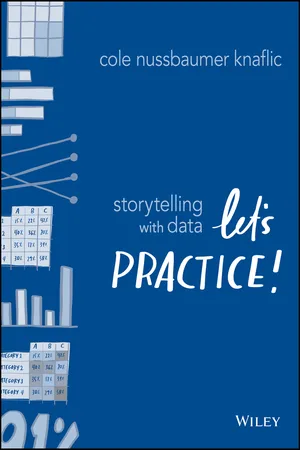
- English
- ePUB (mobile friendly)
- Available on iOS & Android
About this book
Influence action through data!
This is not a book. It is a one-of-a-kind immersive learning experience through which you can become—or teach others to be—a powerful data storyteller.
Let's practice! helps you build confidence and credibility to create graphs and visualizations that make sense and weave them into action-inspiring stories. Expanding upon best seller storytelling with data 's foundational lessons, Let's practice! delivers fresh content, a plethora of new examples, and over 100 hands-on exercises. Author and data storytelling maven Cole Nussbaumer Knaflic guides you along the path to hone core skills and become a well-practiced data communicator. Each chapter includes:
? Practice with Cole: exercises based on real-world examples first posed for you to consider and solve, followed by detailed step-by-step illustration and explanation
? Practice on your own: thought-provoking questions and even more exercises to be assigned or worked through individually, without prescribed solutions
? Practice at work: practical guidance and hands-on exercises for applying storytelling with data lessons on the job, including instruction on when and how to solicit useful feedback and refine for greater impact
The lessons and exercises found within this comprehensive guide will empower you to master—or develop in others—data storytelling skills and transition your work from acceptable to exceptional. By investing in these skills for ourselves and our teams, we can all tell inspiring and influential data stories!
Frequently asked questions
- Essential is ideal for learners and professionals who enjoy exploring a wide range of subjects. Access the Essential Library with 800,000+ trusted titles and best-sellers across business, personal growth, and the humanities. Includes unlimited reading time and Standard Read Aloud voice.
- Complete: Perfect for advanced learners and researchers needing full, unrestricted access. Unlock 1.4M+ books across hundreds of subjects, including academic and specialized titles. The Complete Plan also includes advanced features like Premium Read Aloud and Research Assistant.
Please note we cannot support devices running on iOS 13 and Android 7 or earlier. Learn more about using the app.
Information
chapter one
understand the context
- Considering our audience: identifying who they are, what they care about, and how we can better get to know them and design our communications with them in mind.
- Crafting and refining our main message: the Big Idea was introduced briefly in SWD; here, we’ll undertake a number of guided and independent exercises to better understand and practice this important concept.
- Planning content: storyboarding is another concept that was introduced in SWD—we’ll look at a number of additional examples and exercises related to what we include and how we organize it.




Exercise 1.1: get to know your audience
Solution 1.1: get to know your audience
- Set up time to get a debrief from colleagues who have already met with the new leader. Talk to those who have had conversations with the new head of HR. How did those discussions go? Do they have any insight on this new leader’s priorities or points of interest? Is there anything that didn’t go well from which you can learn and adapt?
- Talk to my manager to get insight. My manager has lunched with the new leader: what insight did he get about potential first points of focus? I also need to understand what my manager sees as important to focus on in this initial meeting.
- Use my understanding of the data and context plus some thoughtful design to structure the document. Given that I’ve been working in this space for a while, I have a big picture understanding of the different main topics that someone new to our organization will assumably be interested in and the data we can use to inform. If I’m strategic in how I structure the document, I can make it easy to navigate and meet a wide variety of potential needs. I can provide an overview with the high level takeaways up front. Then I can organize the rest of the document by topic so the new leader can quickly turn to and get more detail on the areas that most interest her.
Exercise 1.2: narrow your audience
Table of contents
- Cover
- Title Page
- Copyright
- acknowledgments
- about the author
- introduction
- chapter one understand the context
- chapter two choose an effective visual
- chapter three identify & eliminate clutter
- chapter four focus attention
- chapter five think like a designer
- chapter six tell a story
- chapter seven practice more with cole
- chapter eight practice more on your own
- chapter nine practice more at work
- chapter ten closing words
- index
- End User License Agreement